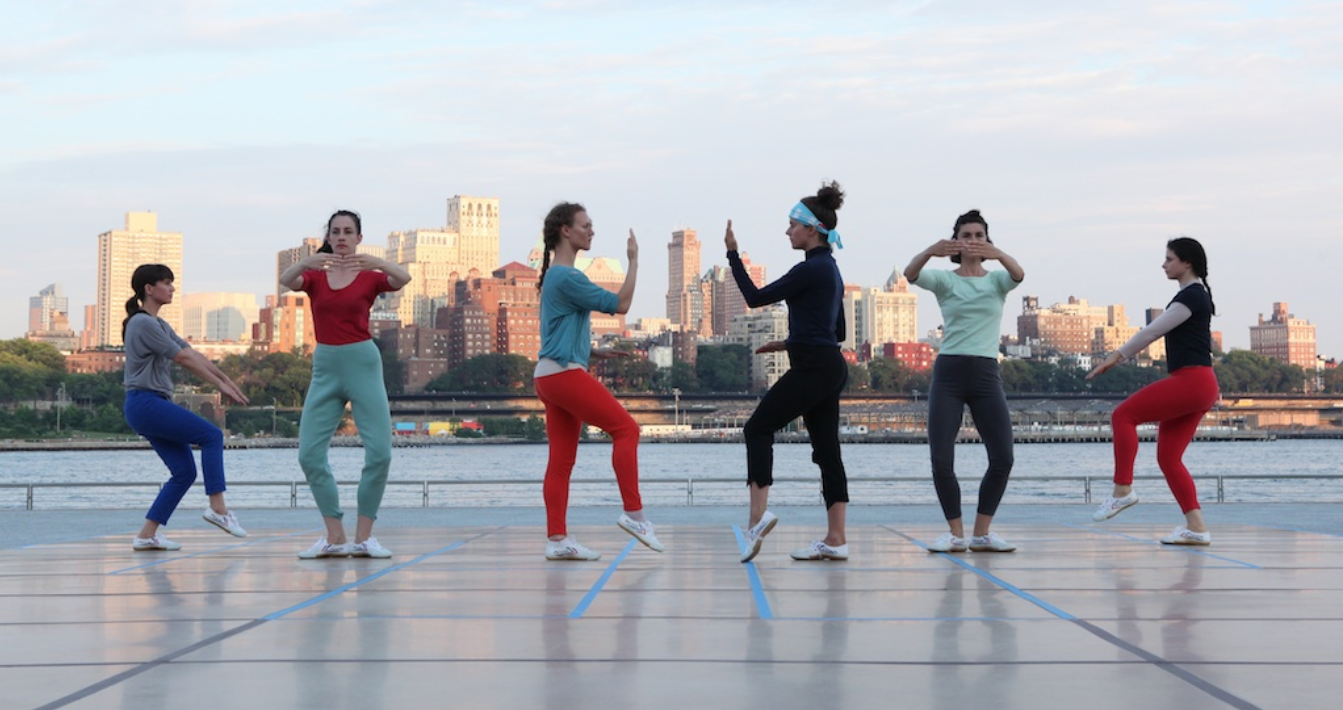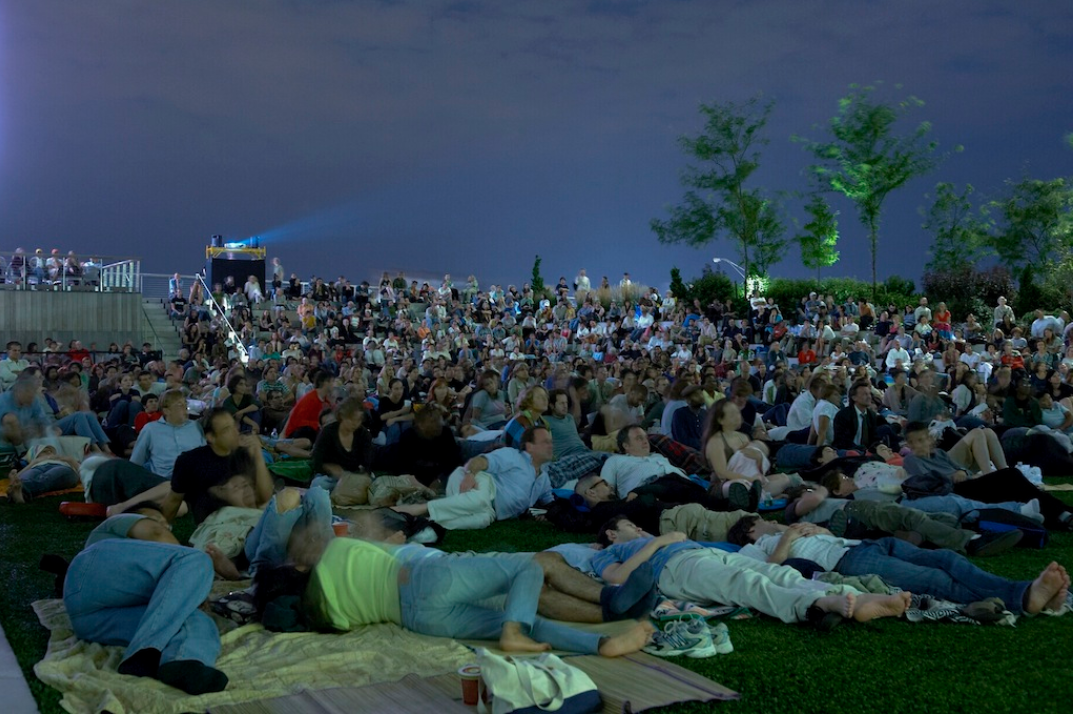Success Looks Different Now: Preface
Rosalie Genevro describes the catalyst for the study and explains its evolution and scope.
July 31, 2013

Beth Gill’s Electric Midwife, presented by the Lower Manhattan Cultural Council (LMCC) as part of the River to River Festival 2012. Performed on Pier 15, with the Brooklyn Bridge Park waterfront and Brooklyn Heights in the background. | photo: Julieta Cervantes. All Rights Reserved.
Success Looks Different Now: Design and Cultural Vitality in Lower Manhattan is the product of an inquiry by the Architectural League, instigated by an idea of the cultural journalist Paula Deitz for a new cultural center on New York’s waterfront. Below, in the preface to the report, Rosalie Genevro describes the catalyst for the study and explains its evolution and scope.
The catalyst for this study was an expression of pure love for the arts and passion for New York City. In a 2008 article in the New York Sun, cultural journalist and critic Paula Deitz proposed that New York should build the kind of waterfront performing arts center that has become a familiar and symbolically resonant feature of 21st-century development in many European cities. Buildings such as the new opera houses in Oslo and Copenhagen signal that, as the space demands of industry and commerce have shrunk, contemporary cities are taking possession of their waterfronts and remaking them as places for cultural production. Situated on one of the most magnificent harbors in the world, New York, she argued, should be similarly ambitious in marrying the magnetic draw of the waterfront with the cultural activity that is so essential a part of the city’s significance as a world capital.
Her idea caught the imagination of Dana Gioia, then-chairman of the National Endowment for the Arts, who suggested a chairman’s grant to explore the possibility of creating such a facility on New York’s waterfront. Paula came to the Architectural League to ask if we would work with her to explore the idea. We accepted her invitation with the provisos that the investigation be open-ended and that it address the many issues surrounding such an undertaking. Thinking about a new cultural facility on the Lower Manhattan waterfront touches on a number of fascinating topics: how New York has reconceived and rebuilt Lower Manhattan since 9/11 and what role the arts and cultural infrastructure have played in that rebuilding; the positioning and use of the entire New York waterfront in the city’s plans for its immediate and long-term future; New York’s competitiveness in relation to other world cities, the significance of culture as part of the city’s competitive advantage, and what sorts of investments in culture will be most effective in sustaining and building that advantage; how the production and consumption of culture are evolving; who makes up the audience for the arts in Lower Manhattan today; and how building projects and design quality interact with cultural vitality and affect the viability of cultural institutions.

The Elevated Acre at 55 Water Street, a publicly accessible space on an elevated plaza adjacent to New York’s largest office building by floor area. Designed by Rogers Marvel Architects with Ken Smith Landscape Architect, the Elevated Acre offers views of New York Harbor and the Brooklyn Bridge, as well as a lawn, gardens, and programmed events during spring, summer, and fall. | photo: courtesy Rogers Marvel Architects. All Rights Reserved.
Each of these topics leads directly to a number of New Yorkers actively engaged in projects and policies relevant to consideration of a new cultural facility on the waterfront in New York, and many of these topics have generated a substantial literature over the past decade. Policy makers, economists, sociologists, arts advocates, architectural critics, historians, and others are researching and debating the intentions and impacts of the work of the Lower Manhattan Development Corporation, the Port Authority of New York and New Jersey, and the Bloomberg administration as these entities rebuild Lower Manhattan. The highly complex picture of how cultural production and dissemination are changing under the influence of new communications and creative technologies is generating a fascinating body of theories and speculations; and the actual impacts of investment in facilities for culture, in terms of both effect on cultural activity and urban revitalization and whether they strengthen or weaken institutions, are starting to be thoroughly studied. The investigation we proposed to undertake, in other words, was vast. Ultimately, the information and insights gathered had to be considered in the context of two central questions: Would a new waterfront performing arts facility advance the arts, by supporting innovation and attracting audiences? And would such a facility make an important contribution to the social, cultural, and economic vitality of Lower Manhattan?
Sandy, which was a post-tropical cyclone when it hit New York City in late October 2012, made all too clear that any proposal for New York’s waterfront needs to acknowledge predictions about the impact of rising sea levels and storm surges on the city. Considerations of safety, access, and financial risk are all part of thinking about any new facility for the arts, along with the question of the possible effects of climate-change planning on context: how the character and mix of uses in Lower Manhattan and other neighborhoods surrounding New York Harbor may change as climate-change adaptation has more impact on public and private investment decisions.

Movie Nights at the Elevated Acre, as part of the River to River Festival | photo: courtesy Rogers Marvel Architects. All Rights Reserved.
We were very lucky to engage Ray Gastil to work with us on this analytical essay. Currently chair in design innovation and visiting professor at the Stuckeman School of Architecture and Landscape Architecture at Penn State, Ray has deep experience in urban design and planning as former director of the Manhattan office of the New York City Department of City Planning and planning director for the City of Seattle. Prior to his work with the Department of City Planning in New York, Ray authored Beyond the Edge: New York’s New Waterfront and was executive director of Van Alen Institute: Projects in Public Architecture. To provide comparative context for study of New York’s situation, Paula Deitz has traveled to and written about four of the most praised new waterfront cultural facilities in Europe, in Oslo, Copenhagen, Cardiff, and Reykjavik.
The research we have carried out has led us to a deeper appreciation of the extraordinary dynamism of contemporary culture and, in the process, to an understanding of important and positive ways in which conversation about the role of architecture and design in city building is evolving. The “Bilbao Effect”—the idea, simplistic even when it held sway, that a signature building can in and of itself create a force field of regenerative urban impacts—no longer holds the seductive allure it once did, as the hard experience of many arts organizations has shown that buildings alone do not have that kind of power. In contrast, a more nuanced understanding of what architecture and design can offer has emerged, visible in well-conceived and operated public spaces as well as in efforts to identify opportunities in the existing fabric of the city to insert and support spaces for the arts. The critical importance and power of intelligent public investment are in evidence at every turn.
We hope that this study makes a useful contribution to New York City’s ongoing process of self-creation, and thereby to the stimulation and enjoyment that a vital, complex, productive city gives to residents and visitors alike.

Chrisette Michele at Rockefeller Park, presented by LMCC and Battery Park City Authority as part of the River to River Festival 2011 | photo: GODLIS, courtesy Lower Manhattan Cultural Council. All Rights Reserved.
Success Looks Different Now: Design and Cultural Vitality in Lower Manhattan is a publication of The Architectural League of New York. All Rights Reserved. The report was made possible with public funds from the National Endowment for the Arts. Additional support was provided by the J. Clawson Mills Fund of the Architectural League of New York. To inquire about obtaining a copy of the complete report, email info@archleague.org
Explore
Global culture, civic competition, social impact
What does building for the arts mean in the 21st century?
A conversation on the Museum of Modern Art’s plan for expansion
With demolition of the American Folk Art Museum building underway, watch a conversation on the MoMA’s plan for expansion.
A conversation with Susana Torre
An interview with Susana Torre, who organized a 1977 exhibition about female architects.
